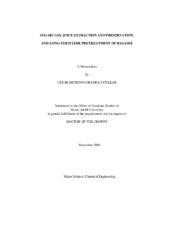| dc.description.abstract | New technologies, such as an efficient vapor-compression evaporator, a stationary lime kiln (SLK), and the MixAlco process, compelled us to re-evaluate methods for producing sugar from cane. These technologies allow more water and lime to be used, and they add more value to bagasse.
Extracting and preserving the sugars, and lime pretreating the bagasse to enhance biodigestibility, all at the same time in a pile, was demonstrated to be unfeasible; therefore, sugar extraction must occur before lime treating the bagasse.
Sugar extraction should occur countercurrently by lixiviation, where liquid moves in stages opposite to the soaked bagasse (megasse), which is conveyed by screw-press conveyors that gently squeeze the fiber in each stage, improving extraction. The performance of a pilot-scale screw-press conveyor was tested for dewatering capabilities and power consumption. The unoptimized equipment decreased megasse moisture from 96 to 89%. Simulation of the process suggested that eight stages are necessary to achieve 98% recovery from typical sugarcane. The cumulative power for the screw-press conveyor system was 17.0±2.1 hp•h/ton dry fiber.
Thin raw juice preserved with lime for several months showed no sucrose degradation and no quality deterioration, except for reducing sugar destruction. The lime loading needed for 1-year preservation is 0.20 g Ca(OH)2/g sucrose. Shorter times require less lime.
After preservation, the juice was carbonated and filtered, and the resulting sludge pelletized. Due to their high organic content, the pellets were too weak for calcination temperatures used in the SLK. The organics must be decreased prior to pelletization and sodium must be supplemented as a binding agent.
Long-term lime pretreatment of bagasse showed two delignification phases: bulk (rapid) and residual (slow). These were modeled by two simultaneous first-order reactions. Treatments with air purging and higher temperatures (50 – 57oC) delignified more effectively, especially during the residual phase, thus yielding higher cellulase-enzyme digestibilities after 2 – 8 weeks of treatment. At temperatures > 60oC, pure oxygen purging is preferred.
Fresh bagasse was of better quality than old bagasse. Treatment with NaOH yielded a larger bulk delignification phase than Ca(OH)2.
Long-term lime pulping of bagasse was unsuitable for copy-quality paper, but it was appropriate for strawboard and other filler applications. | en |


